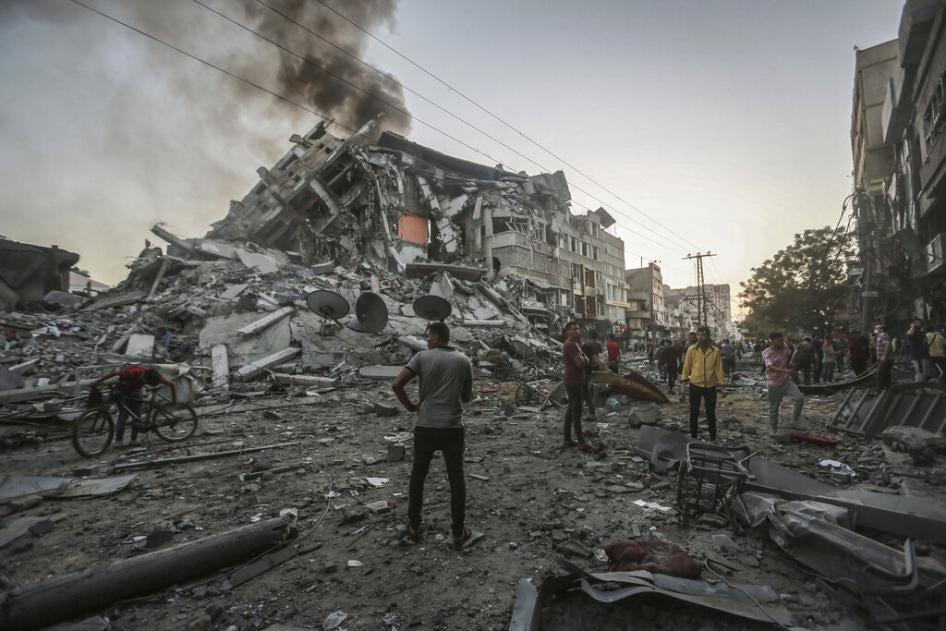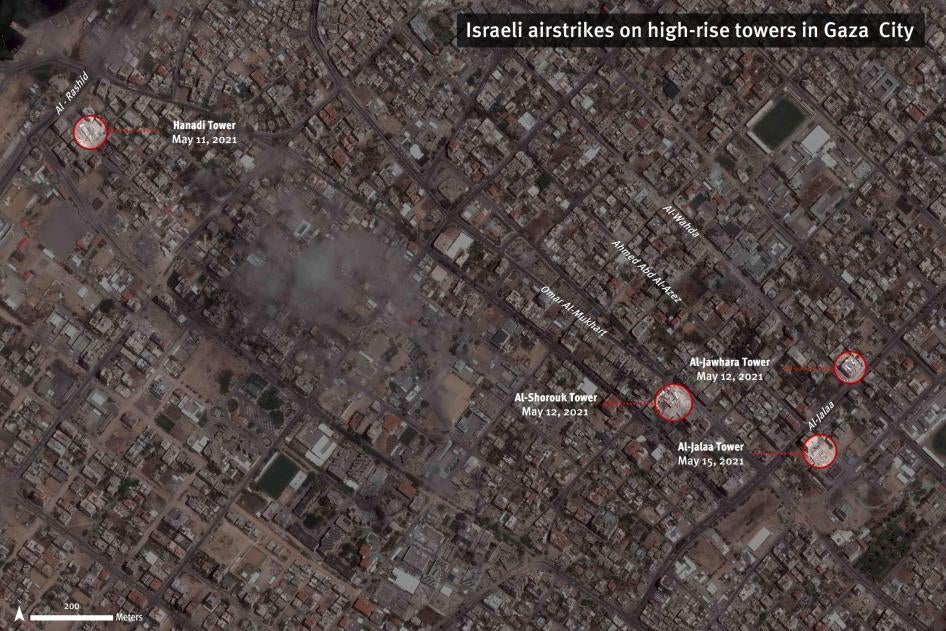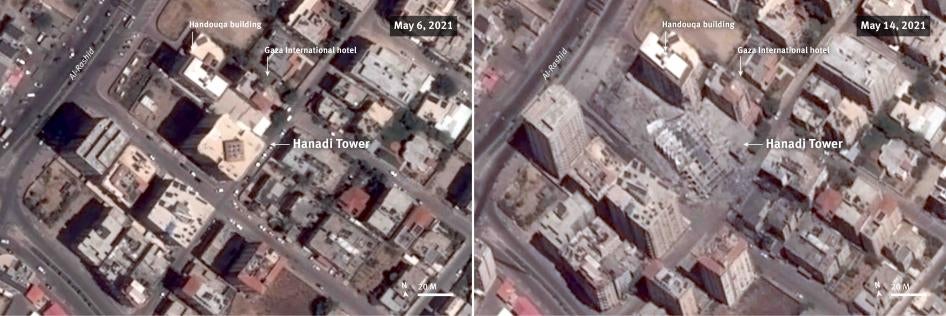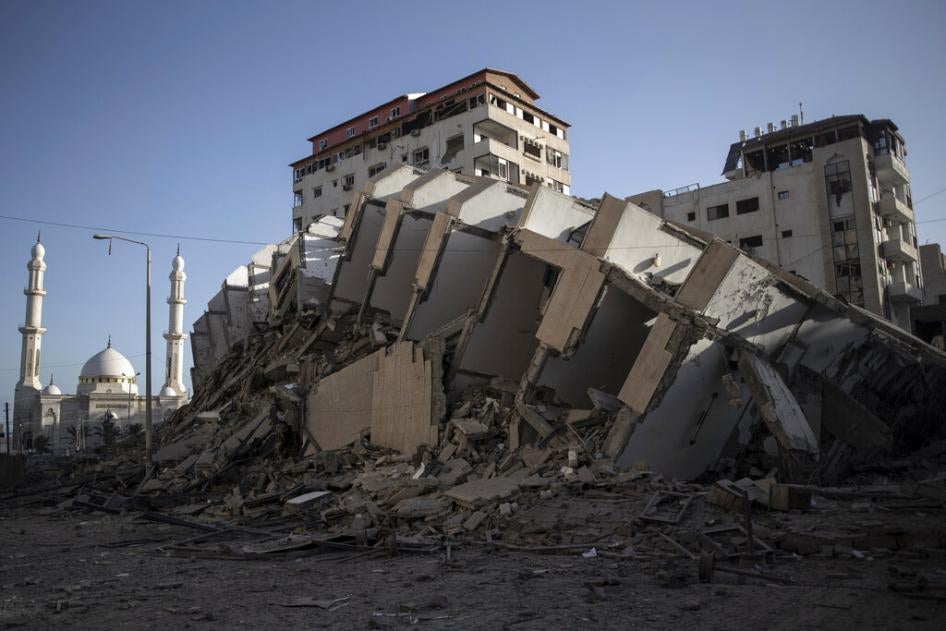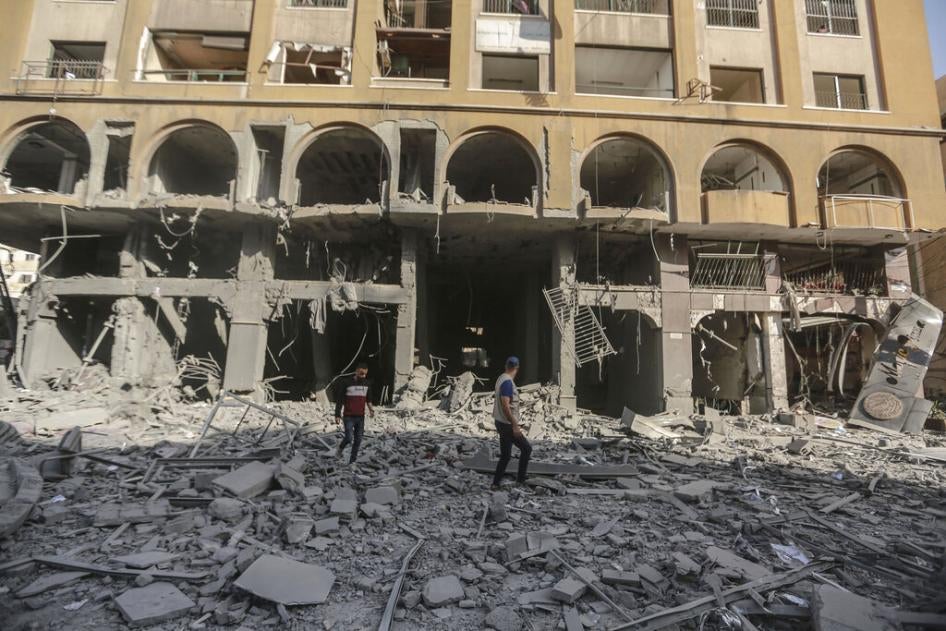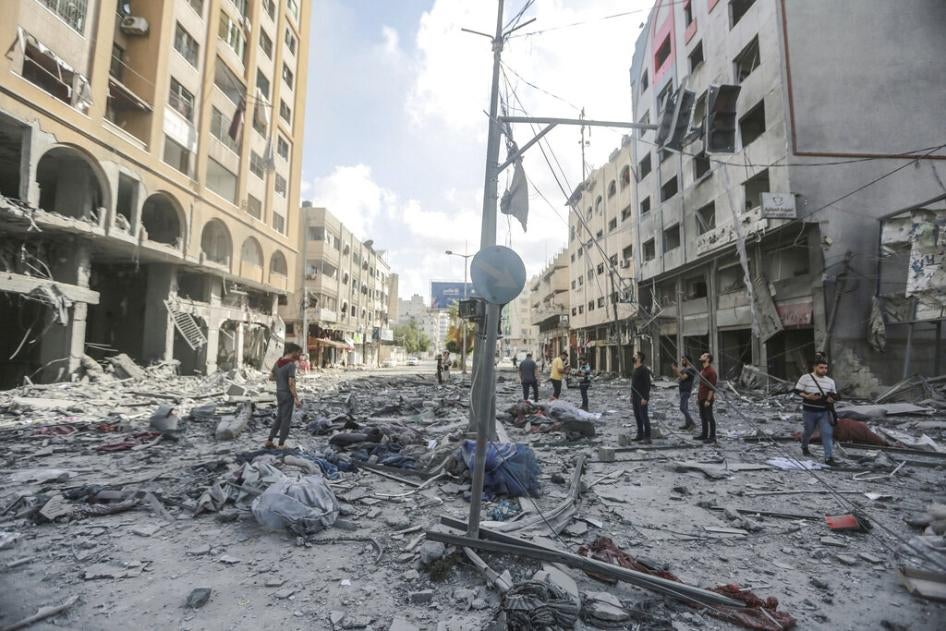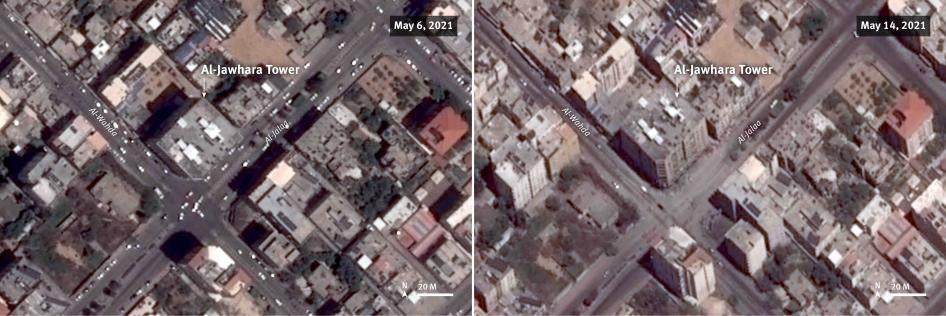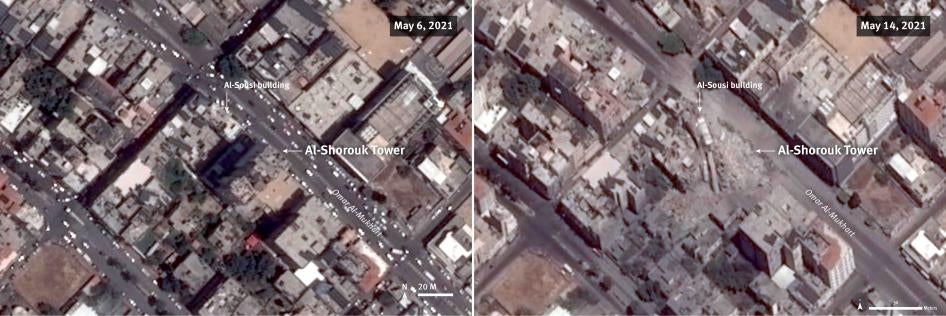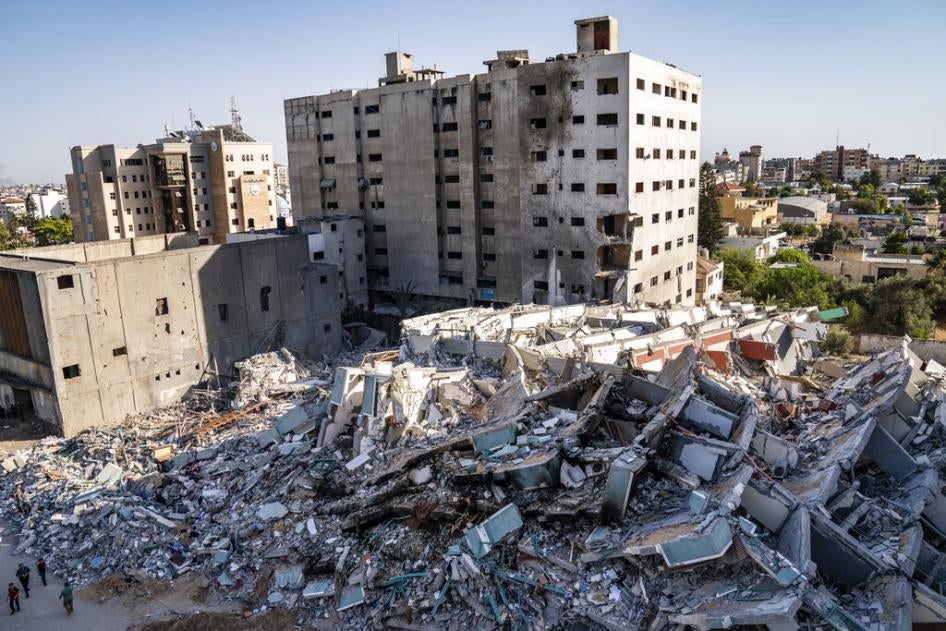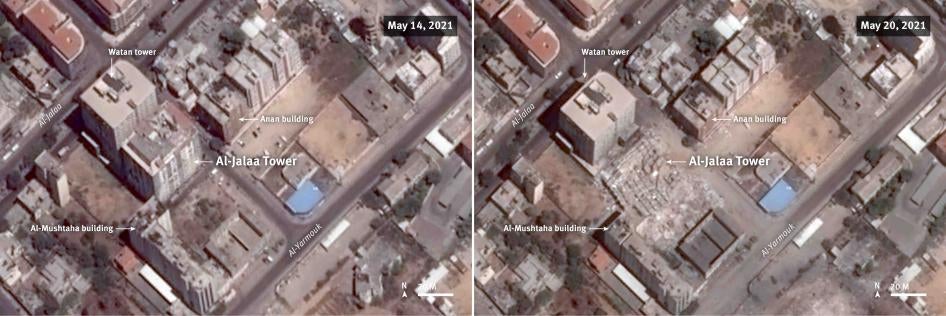The Israeli military’s airstrikes that destroyed four high-rise buildings in Gaza City during the May 2021 fighting apparently violated the laws of war and may amount to war crimes, Human Rights Watch said today. The attacks also damaged neighboring structures, made several dozen families homeless, and shuttered scores of businesses that provided livelihoods to many people.
Between May 11 and 15, Israeli forces attacked the Hanadi, al-Jawhara, al-Shorouk, and al-Jalaa towers in the densely populated al-Rimal neighborhood. In each case, the Israeli military warned tenants of impending attacks, allowing for their evacuation. Three buildings were immediately leveled while the fourth, al-Jawhara, sustained extensive damage and is slated to be demolished. Israeli authorities contend that Palestinian armed groups were using the towers for military purposes, but have provided no evidence to support those allegations.
“The apparently unlawful Israeli strikes on four high-rise towers in Gaza City caused serious, lasting harm for countless Palestinians who lived, worked, shopped, or benefitted from businesses based there,” said Richard Weir, crisis and conflict researcher at Human Rights Watch. “The Israeli military should publicly produce the evidence that it says it relied on to carry out these attacks.”
The Israeli military stated that during the hostilities with Palestinian armed groups in Gaza from May 10 to 21, its forces attacked about 1,500 targets with air- and ground-launched munitions. The United Nations reported that Israeli attacks killed 260 people in Gaza, at least 129 of them civilians, including 66 children. Local authorities in Gaza said that 2,400 housing units were made uninhabitable, while over 50,000 units were damaged, and over 2,000 industrial, trade, and service facilities were destroyed or partially damaged.
Palestinian armed groups launched over 4,360 rockets indiscriminately toward Israel, resulting in the deaths of 12 civilians in Israel, including 2 children, and a soldier, according to Israeli authorities. Human Rights Watch separately reported on Israeli airstrikes that killed scores of Palestinian civilians and Palestinian armed group rocket attacks in violation of the laws of war.
Between May and August, Human Rights Watch interviewed by phone 18 Palestinians who were witnesses and victims of the attacks on the towers, including residents, business owners, and employees, as well as those in affected neighboring structures. Human Rights Watch also reviewed video footage and photographs taken after the attacks, and statements by Israeli and Palestinian officials and Palestinian armed groups.
The towers contained scores of businesses, offices of news agencies, and many homes. Jawad Mahdi, 68, an owner of al-Jalaa tower who lived there with dozens of family members, said, “All these years of hard work, it was a place of living, safety, children and grandchildren, all our history and life, destroyed in front of your eyes ... It’s like someone ripping your heart out and throwing it.”
The long-term effects of the attacks extend beyond the immediate destruction of the buildings, Human Rights Watch said. Many jobs were lost with the closure of their companies and many families were displaced.
Mohammed Qadada, 31, the head of a digital marketing company located in Hanadi tower, said that the 30 employees affected include people who “have families of their own, who were just entering into marriage, who support their older parents, who have sick members of the family who need financial support.” He said they “won’t find work again because the equipment that they had allowed them to do rendering, designing, producing, [has] all been destroyed. So how can they do the work?”
Israel has asserted that the high-rise buildings housed offices of Palestinian armed groups, including the headquarters of certain units, military intelligence, and in one tower, offices for “the most valuable Hamas technological equipment” for use against Israel. Any information to support these claims has not been made public.
Human Rights Watch found no evidence that members of Palestinian groups involved in military operations had a current or long-term presence in any of the towers at the time they were attacked. Even if there were such a presence, the attacks appeared to cause foreseeably disproportionate harm to civilian property.
Under international humanitarian law, or the laws of war, warring parties may target only military objectives. In doing so, they must take all feasible precautions to minimize harm to civilians, and unless circumstances do not permit, provide effective advance warnings of attacks. Deliberate attacks on civilians and civilian objects are prohibited, including reprisals against civilians. The laws of war also prohibit indiscriminate attacks, which include attacks that do not target a specific military objective or do not distinguish between civilians and military targets. Attacks in which the expected harm to civilians and civilian property is disproportionate to the anticipated military gain are also prohibited.
Personnel or equipment being used in military operations are subject to attack, but whether that justifies destroying an entire large building where they might be present depends on the attack not inflicting disproportionate harm on civilians or civilian property. The proportionality of the attack is even more questionable because Israeli forces have previously demonstrated the capacity to strike specific floors or parts of structures. However, these attacks completely flattened three of the buildings, evidently by attacking their structural integrity. Regarding al-Jalaa tower, the Israeli military said that because armed groups had occupied multiple floors, the entire tower needed to be destroyed.
The deployment of Palestinian armed groups in the towers, if true, would go against requirements to take all feasible precautions to minimize harm to civilians under their control and to avoid placing military objectives in densely populated areas. Israel has repeatedly accused Palestinian armed groups of deploying among civilians and – without providing evidence, using them as “human shields” – the war crime of intentionally co-locating military forces with civilians to deter targeting those forces.
Individuals who order or commit serious violations of the laws of war with criminal intent – that is, deliberately or recklessly – are responsible for war crimes. A country responsible for laws-of-war violations is obligated to make full reparation for the loss or injury caused, including compensation for individuals harmed.
The 14-year Israeli closure of Gaza, along with Egyptian border restrictions, has devastated the economy in Gaza. Restrictions on the entry of goods broadly deemed to be “dual-use,” for example, have sharply reduced the population’s access to construction material and certain medical equipment. Unless lifted or substantially eased, the sweeping restrictions on the movement of people and goods will hamper reconstruction efforts.
On May 27, the UN Human Rights Council established a Commission of Inquiry to address violations and abuses in the Occupied Palestinian Territory and Israel, including by advancing accountability for those responsible and justice for victims. The commission should examine unlawful attacks committed by Israeli forces and Palestinian armed groups during the May fighting. It should also analyze the larger context, including the Israeli government’s discriminatory treatment of Palestinians.
“Throughout the May hostilities, unlawful Israeli strikes not only killed many civilians, but also destroyed high-rise towers, wiping out scores of businesses and homes, upending the lives of thousands of Palestinians,” Weir said. “Donor funding alone will not rebuild Gaza. The crushing closure of the Gaza Strip needs to end, along with the impunity that fuels ongoing serious abuses.”
May Hostilities
The May 2021 fighting followed efforts by Jewish settler groups to evict and confiscate the property of longtime Palestinian residents in East Jerusalem. Palestinians held demonstrations around East Jerusalem, and Israeli security forces fired teargas, stun grenades, and rubber-coated steel bullets, injuring hundreds of Palestinians.
On May 10, Palestinian armed groups in Gaza started to launch rockets toward Israeli population centers. The Israeli military attacked the densely populated Gaza Strip with missiles, rockets, and artillery. Many of the attacks by the Israeli military and Palestinian armed groups used explosive weapons with wide-area effects in populated areas. A ceasefire went into effect on May 21.
The May hostilities, like those in 2008, 2012, 2014, 2018, and 2019, among others, took place amid Israel’s sweeping closure of the Gaza Strip, which began in 2007. They also took place in a context of discriminatory efforts to remove Palestinians from their homes in occupied East Jerusalem, policies and practices among the Israeli government’s crimes against humanity of apartheid and persecution, as Human Rights Watch has documented.
Human Rights Watch on May 30 requested permits for senior researchers to enter Gaza to conduct research on the fighting, but Israeli authorities on July 26 rejected the request. Israeli authorities have since 2008 refused access to Human Rights Watch international staff to enter Gaza, except for a single visit in 2016.
On July 13, the Israel Defense Forces (IDF) Spokesperson responded to a June 4 Human Rights Watch letter asking detailed questions about the attacks, saying that the Israeli military “strikes military targets exclusively, following an assessment that the potential collateral damage resulting from the attack is not excessive in relation to the expected military advantage.” The military added that it was making inquiries and investigating “various incidents” in order “to assess whether the obligatory rules had been breached and to draw conclusions.”
Attacks on High-Rise Buildings
The strikes on the four towers that Human Rights Watch investigated were just a small fraction of the Israeli military’s attacks in Gaza during the May fighting.
In each instance, the Israeli military warned residents of the impending attack by calling a building manager, security guard, or tenant, waited for individuals to evacuate, then launched smaller munitions that were either non-explosive or had small explosive yields – which the Israeli military calls “a knock on the roof” – and then carried out airstrikes. Three of the four buildings were immediately leveled. Although no deaths or injuries of fighters or civilians were reported, the attacks destroyed civilian property worth millions of US dollars.
Human Rights Watch research into the attacks on the four towers found no evidence that members of Palestinian groups involved in military operations were in the buildings or had a long-term presence. One businessman said that Hamas had offices in Hanadi tower, but he could not identify who the tenants were or what they did, or that they had any links to Hamas’s armed wing. Under the laws of war, civilian officials not involved in military operations are not subject to attack. Media offices are civilian objects unless they are taking a direct part in the hostilities by communicating military information.
The destruction of businesses and residences in the towers may have long-term implications for the enjoyment of basic rights of those affected, including access to an adequate standard of living, such as water, food, and housing, and loss of livelihoods. The displacement of families can impair their physical security, access to health care, and family life. The destruction of a dozen offices of media outlets undermines the collection and dissemination of information in Gaza.
The size of the blast following the munitions impact and subsequent detonation, as captured in videos either distributed by the Israeli military or circulated online and reviewed by Human Rights Watch, appear consistent with the use of munitions with large high-explosive warheads. These explosive weapons produced wide-area effects, resulting in the complete destruction or serious damage to each of the towers and damage to surrounding areas, including to homes, businesses, and infrastructure.
The Hanadi Tower
At about 6 p.m. on May 11, the Israeli military called the security guard at Hanadi tower to notify him that the 13-story tower would be attacked and that occupants should evacuate, said Maher Awad Kamal Safadi, 36, a local resident and business owner. Israeli forces then struck the building and area around it with multiple small munitions, according to Safadi and a video posted online prior to the attack. Then, at around 7:30 p.m., at least one munition hit the side of the building at its base. Seconds later, at least one more munition struck the opposite side at its base and the building quickly collapsed, causing damage to surrounding businesses and homes.
The attack caused no casualties, but its owner, Ahmed Abu Jaber, said that the building and contents destroyed were worth millions of dollars. Damage to a nearby hotel caused hundreds of thousands of dollars in loss.
Following the attack, the Israeli military released multiple statements, images, and a video of the strike. The statements acknowledged the attack and said that Hamas used the building for “military research and development” and that it housed “Hamas military intelligence offices.” One statement posted on the Israeli military’s website said the building housed “multiple military units used by Hamas” and included a “headquarters” for research and development, military intelligence, and “more,” but did not further clarify.
The media reported that the building housed offices of the political leadership of Hamas. A journalist familiar with the tower, who did not wish to be identified, said: “There are political meeting offices for Hamas parliament members and spokespersons in the tower.” While one business owner in the tower said there were Hamas offices in the tower, he was unaware of their purpose.
Hamas, the de facto authority in Gaza, is a group that includes both a political party and an armed wing. Mere membership or affiliation with Hamas is not a sufficient basis for determining someone to be a lawful military target. The laws of war allow the targeting of military commanders in the course of armed conflict, provided that such attacks otherwise comply with the laws that protect civilians. Political leaders not taking part in military operations, as well as civilians, would not be legitimate targets of attack.
Three of the tower’s business owners described the effects of the attack. Nihad Abdellatif Taha, 45, a computer engineer, said damages to his programming and digital marketing company, Portals, headquartered in the tower, were about US$30,000:
I had 36 employees and we were renting two apartments – 360 square meters with furniture, offices, meeting rooms, surveillance cameras – all of this is gone, in addition to very important documents, all the company’s papers are gone, including stamps and the employees’ contracts – all gone.
Mohammed Qadada, 31, founder and chief executive officer of Planet for Digital Solutions, said that when it moved into the tower in 2017, he invested about $40,000 in renovations, furniture, and new equipment, including workstations, laptops, and printers. All of it was destroyed: “It was May 22 when I went to the tower for the first time [since its destruction]. Everything was gone, I saw rubble, I saw remnants of an office, I saw people’s stuff strewn around, I saw people’s memories, I saw everything fallen.”
As of late May, the company’s 30 employees had all been unemployed since the attack.
Maher Awad Kamal Safadi, 36, who owned Friends Gym on the ground floor of Hanadi tower, said that months earlier he had invested over $10,000 in new exercise equipment. “I had a sauna, jacuzzi, Moroccan bath, a fitness room and a weight room, bathrooms, and a full restaurant with fridges and a gas stove” – all of which were destroyed. He said the attack cost the gym’s six employees their jobs and that he would need $150,000 to replace the equipment.
The buildings immediately adjacent to Hanadi tower, particularly to the north, suffered serious damage. Satellite imagery recorded on May 14 shows damage to the southern and western facades of the Handouqa apartment building and the Gaza International Hotel, both a few meters north of Hanadi tower. Images published on May 12 show serious damage to the facades of the two buildings.
Imad Handouqa, 54, the owner of the Handouqa apartment, which had 10 floors and 25 residential apartments, said it was no longer habitable. He said that part of Hanadi tower fell on the building, damaging its foundations and causing some apartment ceilings to come down on the rooms. He said the total value of the structure was about $1.3 million.
The owner of the Gaza International Hotel, Abu Ahmed Jaber, in a video posted on the hotel’s Facebook page, said the damage to the hotel amounts to nearly half a million dollars.
The attack also damaged critical electrical delivery lines for Gaza City and the area immediately around the tower, Gaza’s electricity company said.
al-Jawhara Tower
On the evening of May 11, the Israeli military called residents living next to the tower to inform the tenants of the 11-story Jawhara tower that the primarily commercial building would be targeted and to evacuate. At approximately 10 p.m., Israeli aircraft launched small munitions, striking the roof and the ground near the tower. At around 2 a.m. on May 12, larger air-dropped munitions struck the building, severely damaging it.
Mohammad Atta Hassan Jaarour, 71, a founder and co-owner who lived on the building’s seventh floor, said the damage, including to the foundational pillars, left the building structurally unsound. “The whole building is destroyed,” he said. “It’s still standing, but it’s a skeleton, all the ground floors and the two underground floors all exploded.”
Residents and tenants said the strike caused extensive damage to their apartments, businesses, equipment, and the surrounding neighborhood. One said that the strikes were so intense that “most of the surrounding buildings – the fronts of the buildings and the glass – were destroyed.”
Following the attack, the Israeli military issued a statement saying that the building housed a “headquarters belonging to the Hamas terror organization’s intelligence unit, Hamas Judea and Samaria [West Bank] Headquarters, Public Relations department and the Gaza Brigade.” The Israeli military also released a video of the attack showing at least two munitions striking the building within seconds of one another.
Six days later, the Israeli military released a statement and images, saying it attacked another building that it also said was the Hamas headquarters for the West Bank.
Ahmed Zaeem, a co-owner of al-Jawhara who lived in the building with his parents, wife, and four children and had been there for 17 years, said the tower contained 64 units on eight floors, two underground floors, and a floor dedicated to a shopping mall. “The 64 units include residences, law offices, media outlets, engineering firms, development agencies, [and information technology] companies,” Zaeem said. “There’s also a dentist. There were no less than 20 stores on the bottom three commercial floors.” Six of the 64 units were residential.
Zaeem said the overall economic loss was $5-7 million to rebuild the building, which did not include the losses in the commercial units and the residential apartments. He said he personally lost about $1.5 million in property he owned in the tower. Jaarour estimated that he lost $1.2 million. “If we had the money, I think we could rebuild it in four to five years,” Jaarour said, citing the Israeli closure and restrictions on the entry of building materials.
Both co-owners described the loss of businesses in which they had invested. Jaarour cited Magic Pizza, which he said had new appliances and furniture and employed about a dozen people: “We were so happy and had been waiting a long time to get it running. In one moment, all of these things turned into an illusion.”
Zaeem and his family ran several offices and stores in the tower, including the Elaine Center women’s clothing shop. He said his wife had invested $20,000 in equipment for a new photography studio, Studio Wateen Photographer, which had been set to open soon.
The building also contained SMT Solutions, an information technology company that provides internet to areas throughout Gaza. A post on the company’s Facebook page on May 13 said that the fiber optic networks, data center, and the company’s headquarters were destroyed in the attack and would take six months to repair.
The tower also housed the Young Journalists Radio Club, Gaza’s only radio broadcast for children. Ghassan Radwan, 51, owner of the radio club, said it had eight people working at the radio station and more than 20 children who ran the programming and did the broadcasting. Everything in their office was destroyed and to rebuild the network would cost about $70,000, but that would require overcoming the restrictions on the entry of communications equipment due to the Israeli closure and Egyptian restrictions.
The official Palestinian news agency, Wafa, listed the offices of 11 media outlets in the building: London-based Qatari broadcaster Al-Araby TV; news website and newspaper Felestin; Iraqi broadcaster Al-Etejah TV; Al-Kofiya TV; Jordanian broadcaster Al-Mamlaka; Sabq24 News Agency; news website Al-Bawaba 24; the production company Watania News Agency; the local photo agency APA Images; Al-Nujaba TV; and the Syrian state-owned broadcaster Syria TV. However, Human Rights Watch was not able to independently verify whether Al-Nujaba TV, Syria TV, and APA Images were located in the tower.
The tower also contained the offices of the media rights group Forum of Palestinian Journalists, and the Palestinian Forum for Democratic Dialogue and Development.
When Zaeem visited his home in the tower after the attack, he found it destroyed: “The furniture was ripped, the curtains, things turned over – everything was broken. The bathroom doors were all broken, the tiles came off the floors, the roof on the apartments are weak and would leak if there’s any water.” In early June, Zaeem said he and his family were living with a friend while looking for somewhere new to live.
al-Shorouk Tower
On the afternoon of May 12, the Israeli military phoned the 14-story Shorouk tower’s security guard, who then informed the tenants that the building would be attacked and that they needed to evacuate. Approximately 30 minutes after the phone warning, Israeli aircraft launched lower-yield explosive munitions against the structure. A few minutes later, Israeli aircraft struck the tower with multiple, large air-dropped munitions, critically damaging the structure, causing two parts of the building to collapse but leaving the center – and tallest part of the building – standing. About 10 minutes later, Israeli aircraft attacked the remaining part of structure, using two large, air-dropped munitions, causing the final element to collapse onto nearby shops and homes.
No one was killed or injured as a result, but the owners of the tower and businesses in the building, as well as adjacent buildings, described destruction and damage to scores of businesses and at least a half-dozen homes.
Following the attack, the Israeli military released a graphic of the building and a statement that said “[t]he building housed Hamas military intelligence offices, as well as infrastructure used by the terror organizations to communicate tactical-military information.”
Ahmed Masoud al-Mughanni, 60, chairman of the building’s board of directors, said that the building had 50 offices and a coffee shop – “doctors, lawyers, journalists’ offices” – and empty residential apartments. He estimated that the cost of rebuilding the tower would be between $2 and $3.5 million and take several years.
The attack destroyed the offices of several media outlets in the building: Al-Aqsa TV and Al-Aqsa Radio; the Palestine Media Production Company; Al-Quds Today; and a Palestinian Authority-affiliated newspaper, Al-Hayat al-Jadida.
The Palestine Media Production Company rented five apartments on floors 5, 9, and 13. Ismail Abdelghani Ismail Jabr, 27, whose father owns the company, said the company had been operating in the building since 1994 and employed 17 people at the time of the attack. Jabr and Mohammad al-Buhaisi, 30, a producer, said the company produces television and video reports, films, and stories for numerous foreign news outlets. Just prior to the attack, they managed to remove equipment from one of their two studios, but the remainder of their equipment was destroyed, along with eight years of archived material.
Witnesses to the attack said that when the tower came down, it damaged numerous shops and homes in the area, including the al-Sousi shopping complex, a nearby restaurant, and the Hassania building.
Ahmed Ayman Mohammad Omar al-Sousi, 27, who lived in the building next to al-Shorouk tower with his extended family of 42 in six separate apartments, said they owned and operated 10 ground-floor stores that sold accessories, clothing, and embroidery. He said that when the central part of al-Shorouk tower collapsed, it fell on their businesses and residences: “The amount of damage in the area from the tower falling is horrific. Flames lit up in the area – our building was on fire. The 10 stores and five storage rooms were all burned.”
Because it was Eid season, the stores and storage rooms were full of merchandise, all of which was destroyed, he said.
Al-Sousi said the fires caused by the explosions burned for three days and did the most damage. He estimated that the destruction of the store he owned with his father caused losses of about $120,000. All seven people employed at the shop, including several family members, lost their jobs. As of early June, he said the employees from the nine other stores were also out of work.
Along with the businesses, four of the six apartments where the al-Sousi family lived were also destroyed or seriously damaged either by the collapsing tower or the resulting fire. “The tower is now on our house – how are we going to lift it,” al-Sousi said. Al-Sousi’s extended family members all had to find new homes.
al-Jalaa Tower
On the afternoon of May 15, a man who identified himself as “Danny” from the Israeli military spoke in Arabic on the phone to the nephew of Jawad Mahdi, 68, the owner of the 14-story Jalaa tower. His voice was captured on a cell phone threatening a reprisal attack: “Because they [Palestinian armed groups] shot at Israel and they shot at Tel Aviv, we are now going to hit and strike the entire tower.” The phone was handed over to Madhi. “Danny” told Mahdi to inform the tenants that the building would be targeted and to evacuate all the floors.
Human Rights Watch sent questions to the Israeli military inquiring as to the authenticity of the recording and whether the statements made reflected Israeli military policy, but, as of the date of publication, have not received a response.
At about 3 p.m., Israeli aircraft fired small munitions at the building. Within minutes, Israeli aircraft attacked the tower using at least two air-dropped munitions near the base of the building on two sides and it immediately collapsed.
No one was killed or injured because everyone had evacuated, but residents and tenants say that in addition to the destruction of the building, they lost everything in their homes and businesses, including equipment and records. The building housed bureaus of Al Jazeera English and the Associated Press.
Following the attack, the Israeli military posted an image and video, and issued several statements that sought to justify it. Israeli military officials and politicians, including then-Prime Minister Benjamin Netanyahu, also issued statements or addressed the media on the subject. These statements changed over time, describing the threats posed by the alleged militant presence as increasingly serious.
On the day of the attack, the Israeli military stated that the building “contained military assets belonging to the intelligence offices of the Hamas terror organization.” Later that day, it said it “housed the Hamas Research and Development unit, which is responsible, among other things, for terror activity carried out against the State of Israel.” The same statement added that this unit included “subject matter experts (SMEs) which constitute a unique asset to the Hamas terrorist organization. These SMEs operate the most valuable Hamas technological equipment against Israel.” The then-military spokesperson, Lt. Col. Jonathan Conricus, told Reuters later that day that the offices occupied by Palestinian armed groups were located on multiple floors.
On May 16, the Israeli military’s official Twitter account stated in a post that the tower was an “important base of operations for Hamas’ military intel” and that, along with gathering intelligence, it “manufactured weapons and positioned equipment to hamper IDF operations.” In a second post, minutes later, it said that Hamas and Palestinian Islamic Jihad removed equipment following the military’s warning to tenants and residents, though it did not specify which equipment.
On May 17, then-Prime Minister Netanyahu said on the US-television network CBS that the building had “an intelligence office for the Palestinian terrorist organization housed in that building that plots and organizes attacks against Israeli citizens.” An unnamed senior Israeli military official later told the New York Times in an article published on May 21 that the building contained electronic jamming equipment. Israel has provided no evidence to support any of these allegations.
Tenants, residents, and the owner of the building have rejected Israeli claims that armed groups had a presence in the building.
The Associated Press’s president and CEO, Gary Pruitt, said: “We have had no indication Hamas was in the building or active in the building. This is something we actively check to the best of our ability. We would never knowingly put our journalists at risk.”
Mahdi, who is also a resident, said that the building was worth about $5 million and that he estimated another $2 million in furniture and appliances were destroyed.
A list that Mahdi produced for receiving compensation from authorities in Gaza for damage to the tower shows over 50 individual businesses and offices on five floors and the two rooftops. Residences filled the other five floors, many of them inhabited by Mahdi’s relatives. He said that 30 families were living in the building at the time of the attack, a total of about 130 people. Mahdi said he and his extended family owned 10 units.
Fares al-Ghoul, 30, who works for al-Mayadeen Media Group, which had offices in al-Jalaa tower, said that he was in his office on the third floor with five colleagues when the superintendent told them to evacuate:
I didn’t know what to do. Imagine the situation, the superintendent comes to you crying, saying “Quick! Quick! Get out! They’re going to bomb the building.” So, the five others and I took the equipment we could and left behind equipment worth $200,000, because we just didn’t have enough time.
The equipment destroyed included a satellite transmitter, which he said costs around $120,000, and is extremely difficult to replace because of the Israeli closure of Gaza. Wael Dahdouh, 51, an Al Jazeera correspondent and the Gaza office head, said that he estimated their losses at about $1 million.
Ramy Haddad, 46, the head of the Central Blood Lab, part of the Palestine Future Foundation for Childhood, offers tests and regular follow-ups for patients of thalassemia, a rare blood disorder. The lab had several pieces of special equipment to run these tests, all of which were destroyed. Haddad estimated the losses at $70,000 and said it would be difficult to replace some of the specialized medical equipment due to Israel’s entry restrictions.
Several engineering and consulting firms also occupied offices in the building. Khaled Omar Abu Sultan, 58, director of Ro'yatak, an engineering consulting and management business housed in the tower since 2020, said the firm designed hospitals, schools, roads, and other infrastructure. At the time of the attack, he and his employees were at home and did not have time to retrieve anything from the office. He estimates the losses in office equipment at about $15,000: “The main loss is a large archive of projects – our plans, files, references and documents. We had printers and equipment for photographing maps.” Sultan said they had to stop work on all current projects until they can buy new equipment.
Khaled Majed Abu Rahma, 30, works with his father at Al-Burj for Engineering Consultations and Design, which has been in al-Jalaa tower for 15 years. He said the firm makes engineering plans and employs 10 engineers, including those with specialties in civil, architecture, mechanical, and electrical engineering. The firm helped to plan homes, villas, and multi-story buildings in Gaza. “We lost everything – the whole office, the furniture, the files,” he said. “We didn’t take anything.”
Rahma estimated that the apartment, which they owned, cost $72,000 and the equipment and furniture lost was a little over $19,000. All 10 engineers lost their jobs as a result of the attack.
The attack also damaged civilian structures around the building. Mahdi said: “The surrounding buildings and homes suffered a great deal of damage, some were destroyed ... The Al-Mushtaha building near us suffered the most damage.” He said that the front of the adjacent building owned by the Anan family also suffered damage.
Al-Ghoul said that the buildings next to the tower, including the Watan tower and Anan building, and across the street were also damaged.
Dahdouh said that the whole block was evacuated, but when residents of other buildings tried to return, they found their homes damaged and could not go back right away.
The destruction of al-Jalaa tower left the 30 families who lived in it homeless and seeking shelter elsewhere. Mahdi said that “Our family got separated – each one of us went to a separate house. We found two homes to rent – we’re waiting for another five homes so we can all be together.”
Long-term, “Reverberating” Effects, and Gaza’s Closure
In addition to the damage and destruction to the towers and their offices and residences, the attacks can be expected to have various “reverberating” effects – harm to civilians and civilian objects caused by the attack that are not direct or immediate. These include displacement and a reduced standard of living and impaired access to shelter, health care, and basic services such as electricity, all of which affect the enjoyment of basic human rights.
In Gaza, these effects are exacerbated by the generalized closure that Israel has imposed on Gaza since 2007 – policies that Egypt, which borders Gaza to the south, does little to alleviate by maintaining its restrictions. The Israeli closure, along with Egyptian border restrictions, has devastated Gaza’s economy. Eighty percent of Gaza’s people rely on humanitarian aid and more than half live below the poverty line. In 2020, the unemployment rate was above 40 percent.
Israeli authorities justify the Gaza closure on security grounds. But the ban on the movement of more than two million people, with narrow exceptions, based on generalized threats, and the sweeping restrictions on the entry and exit of goods, violates Israel’s obligations under international human rights and humanitarian law to ensure that the needs of the population are met.
Israeli authorities, for example, severely restrict the entry of so-called “dual-use” items that could be used for military purposes, such as the construction of tunnels or fortifications. However, the “dual-use” list includes both overly broad categories and items that are vital to meet the needs of Gaza’s population, including “communications equipment,” “steel elements and construction products,” “drilling equipment,” and certain medical equipment .
These restrictions have sharply reduced the population’s access to construction material and other goods vital to the rebuilding of Gaza and its infrastructure. The Israeli military argues that armed groups in Gaza use cement to build tunnels and estimate that constructing a kilometer of tunnel requires a few hundred tons of cement. But people in Gaza need over a million tons of cement annually to build and maintain homes, schools, health clinics, the water system, and other vital infrastructure.
The recent destruction and damage to tens of thousands of residential and commercial buildings and infrastructure caused by Israeli strikes increases the need for building materials to repair and rebuild these structures. The Israeli authorities should not restrict an overwhelmingly civilian good, badly needed for rebuilding, because armed groups may use a small fraction of it to build tunnels or for other military purposes.
The general inaccessibility of building materials means that any reconstruction efforts will require substantial time to complete. In interviews with investors and owners at three of the four towers, all said that because of Israel’s closure it would take years just to rebuild the structures. Several owners of businesses that rely on specialized equipment the entry of which is severely restricted, such as broadcasting equipment, expressed concern that rebuilding would be complicated and slow.
On August 13, the Israeli army announced that, in light of the stable security situation at the moment, it would expand the list of goods allowed to enter Gaza, including to allow in “goods and equipment for humanitarian projects.” Palestinian authorities said on August 17 that, according to information they received from Israeli authorities, “construction materials for the private sector and related to humanitarian projects only” would be among the items permitted to enter Gaza. Israeli authorities reportedly allowed some items in on August 19, but it remains unclear to what extent this marks a change in policy and how long these measures will remain in place.
The Israeli government should allow the entry into Gaza of concrete and other materials needed for the reconstruction of civilian infrastructure, subject to, at most, narrowly tailored restrictions based on particularized security assessments.
Unless the closure is lifted or substantially eased, the long-term and reverberating effects of the destruction of the towers and other civilian infrastructure will be exacerbated.
Lack of Accountability
Israeli and Palestinian authorities have a long track record of failing to credibly investigate alleged war crimes by their forces in Gaza. On May 12, the Office of the Prosecutor of the International Criminal Court (ICC) indicated that it was monitoring the situation in Gaza. The prosecutor’s office should include in its Palestine investigation apparently unlawful Israeli attacks in Gaza, as well as Palestinian rocket attacks that struck population centers in Israel.
Judicial authorities in other countries should also investigate and prosecute under national laws those credibly implicated in serious crimes in the Occupied Palestinian Territory and in Israel under the principle of universal jurisdiction.
Warring parties should refrain from using explosive weapons with wide-area effects in populated areas because of the foreseeable indiscriminate harm to civilians. Countries should support a strong political declaration that addresses the harm that explosive weapons cause to civilians and commit to avoid using those with wide-area effects in populated areas.
